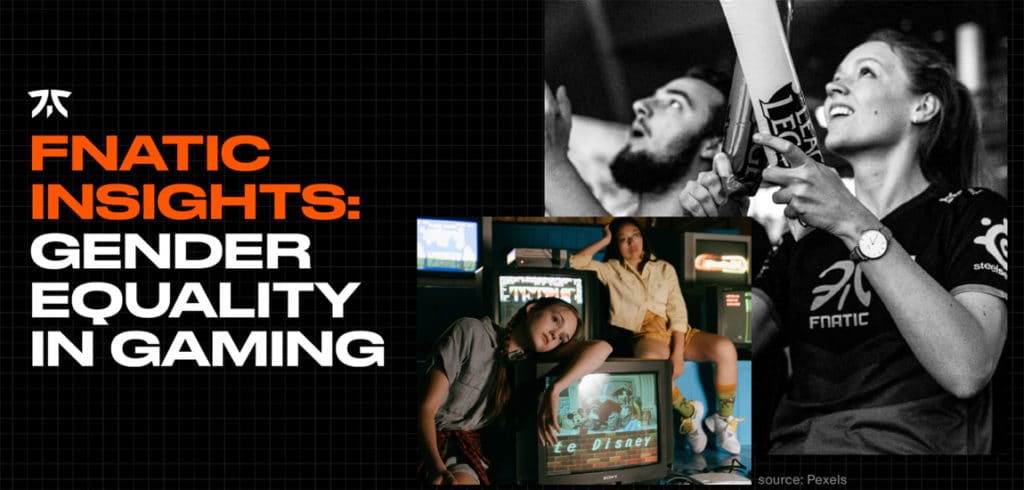London-based esports organisation Fnatic have today published a new report looking into gender inequality in the esports and gaming industry.
Fnatic Insights: Gender Equality in Gaming was created to address the current state of gender equality in the gaming ecosystem, highlight some of the barriers women continue to face and open up the conversation on diversity and equality.
This report uses data from across the industry, and ‘aims to highlight the stark challenges faced by the gaming industry to address its gender imbalances’.
“In the business world, a lot of us 10 or 15 years ago felt there was gender confusion. If we had senior positions in a company we felt we had to act like a man. A lot of us tried it and failed. You can have a lot of business acumen and empathy.”
Anonymous, senior VP for a major streaming platform
The report has been pushed today to mark International Women’s Day.
Fnatic’s head of talent, Soraya Sobh, will also lead a live Clubhouse Q&A on Monday March 15th from 4pm GMT.
Here are ten notable stats and pieces of information from the report:
1. The glass ceiling is real
At the lowest levels of media and entertainment, women get ahead: they are promoted at twice the rate of men, according to this report.
However, every time an aspiring female executive takes a step up the ladder, the fewer women she will encounter: women hold only 27 percent of C-suite positions in the global entertainment sector.
In gaming specifically, only 3% of females were in a director role or higher, with a majority of 29% in mid-level or 18% in lead roles, meaning the majority of females within the ecosystem are entry level or earlytenure.
An analysis of the UK gaming workforce by Ukie, using a data set of over 3,200 respondents, found that 70% of industry employees are male.
2. There’s a lack of role models

“A constant theme throughout the world of gaming is the notable lack of female role models both in the business ecosystem and on stream, particularly competitive play,” the report states.
“If role models can be found from within organisations and championed for their work, not their gender, we may start to see a shift in perspective. The gaming industry must now do more to provide role models for younger generations, and inspire the next wave of creators, gamers and executives to aspire to be like someone similar to them.
“Only once we truly acknowledge the challenges of inequality as they currently stand, can we explore the opportunities that will move us into a better future.”
It’s true that some in esports and gaming have tried to address this. Intel and ESL had a push with their AnyKey diversity initiative and women’s tournaments at Intel Extreme Masters in the past, though this was dropped last year.
The report also looked at the lack of women representation in games themselves, such as the number of women protagonists compared to men.
3. What women say
It’s refreshing to see a report including some off-the-record anonymous comments from both women streamers and other professionals in the games industry.
This allows people to have their say openly and speak their mind, without thinking about how saying something could net them criticism.
One streamer said anonymously: “One of the biggest challenges I face is being taken seriously.”
Another, a senior VP for a major streaming platform, added: “In the business world, a lot of us 10 or 15 years ago felt there was gender confusion.
“If we had senior positions in a company we felt we had to act like a man. A lot of us tried it and failed. You can have a lot of business acumen and empathy.”
4. Toxicity and sexism are contributing to a lack of women content creators

This Feminist Media Studies research suggests that cultural problems and toxicity could be limiting the number of women who become content creators or work in esports and gaming.
A survey of the top 100 YouTubers across nine different countries (900 person data set) found 75-80% were male, and the remaining 20-25% were female.
The report stated: “Looking into why this may be, they discovered female streamers are more prone to receive negative, hostile, sexist or inappropriate comments on their channel than males, which is likely to result in females being deterred from earning a living as a YouTube influencer. These issues may also stem from an insufficient pool of role models for current talent in the industry or those curious to enter to model themselves on.”
In addition, although only 2% of the top streamers on Twitch identify as female, female streamers have been increasing in popularity (according to Stream Hatchet).
Related article: Do those who make toxic comments deserve a second chance in esports?
5. Education is a solution
In a survey with women members of Fnatic Network – Fnatic’s grassroots streamer academy – there was a clear call for greater education around the need for gender inclusivity and equality.
Respondents were generally against female-specific events or teams, calling for their capabilities as players and content creators to be judged on their merits, rather than ‘as acts to be assessed principally through a gendered lens’.
“Education is a solution,” the report read. “By giving everyone a level playing field to enter the industry, we can expect to see a more equal mix of representation coming through the junior ranks heading for the top.
“Educational resources will help increase formal training, courses, and recruitment and help dispel existing information in the ecosystem which may be subject to unconscious bias.”
Fnatic listed more mentorship, support and guidance, and increasing general awareness of unconscious bias as possible solutions to focus on.
You can download the full white paper at insights.fnatic.com/equalityreport
Must-Read Casino & Betting Guides
Check out our featured gaming guides to find top UK casinos, no verification sites, fast withdrawal platforms, and more.
- Best Online Casinos in the UK
- Best Betting Sites UK for 2025
- Top UK Esports Bookmakers
- Non Gamstop Casinos UK
- Best Crypto Casino Sites

Dom is an award-winning writer and finalist of the Esports Journalist of the Year 2023 award. He has almost two decades of experience in journalism, and left Esports News UK in June 2025.
As a long-time gamer having first picked up the NES controller in the late ’80s, he has written for a range of publications including GamesTM, Nintendo Official Magazine, industry publication MCV and others. He also previously worked as head of content for the British Esports Federation.


